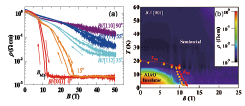Field Induced Quantum Metal-Insulator Transition in the Pyrochlore Iridate Nd2Ir2O7
Nakatsuji and Kindo Groups
Recently, the iridium oxides (iridates) have attracted tremendous attention for their unique position amongst correlated electron materials, balancing comparable electronic kinetic energy (bandwidth), Coulomb interaction (U), and spin-orbit coupling. This makes them susceptible to novel quantum effects, forming topological phases, and phase transitions. Nd2Ir2O7 as a member of pyrochlore iridates, is a rare example of a weak Mott insulator, which undergoes a continuous metal-insulator transition (MIT) at TMI ~ 32 K, the transition closest to the T = 0 quantum MIT in this class of materials. Hence, novel quantum critical Mott transitions, quantum spin liquid phases, and other exotic states are expected to emerge in this weak Mott insulator. Here, we report for the first time a quantum phase transition between a magnetic insulating state and a metallic state driven by magnetic field. Our discovery may be potentially important for applications, showing how to tune the metal-insulator transition by applying magnetic field in a weak Mott insulator.

Fig. 1. (a) Field-dependent magnetoresistivity with increasing and decreasing field at T=2 K for various field directions between [001] and [110] directions. The angle Θ is measured from the [001] directions. (b) Temperature-field phase diagram for Nd2Ir2O7 under a magnetic field along [001] direction.
Anisotropic magnetotransport measurements were performed under high magnetic field up to 50 T using high quality Nd2Ir2O7 single crystals. Strikingly, a strongly anisotropic field induced quantum metal-insulating transition was discovered in this cubic symmetric material. The insulator state can be suppressed by such a field ~ 10 T to a zero temperature quantum MIT only for fields near the [001] axis, as shown in Fig. 1(a). The strong sensitivity to the field direction is remarkable for a cubic crystal, as is the fact that the MIT can be driven by such a small magnetic field, given the 45 meV gap energy, which is ~ 50 times larger than the Zeeman energy for an Ir4+ spin.
We mapped out the temperature-field phase diagram for Nd2Ir2O7 under magnetic field along the [001] direction. As shown in Fig. 1(b), a systematic change in the MIT from continuous near zero field to first order under fields indicates the emergence of possible tricritical point proximate to the quantum phase transition, consistent with the hysteresis seen in the field dependent data shown in Fig. 1(a). Notably, this systematic change across the tricritical point may exist only for the case using high quality single crystals. This new insight contributed to the understanding of quantum MIT behavior. The theorists have constructed a Kondo lattice model considering the strong Kondo coupling between Nd-moments and Ir conduction electron sites, emphasizing the essential role of Nd physics in this quantum MIT picture under magnetic fields.
References
- [1] Z. Tian, Y. Kohama, T. Tomita, H. Ishizuka, T. H. Hsieh, J. J. Ishikawa, K. Kindo, L. Balents, and S. Nakatsuji, Nat. Phys. 12, 134 (2016).
